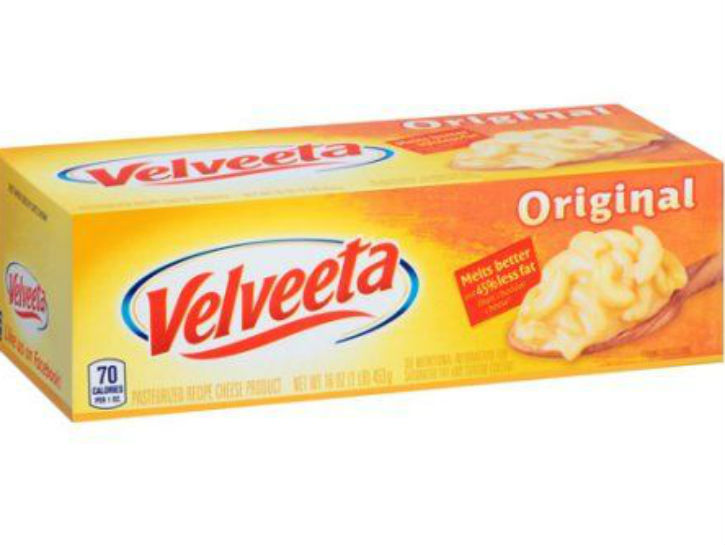Have you ever looked at Velveeta and noticed the words “pasteurized prepared cheese product”? There is a reason why all of those fancy words are on the package – Velveeta is not cheese. In fact, it is so far from being cheese that it can’t legally call itself cheese. Velveeta is, no doubt, a cult classic, but it’s time to have an honest conversation about the uncomfortable truths you might not know about this “cheese product.”
Velveeta History

In the early 20th century, Monroe Cheese Company was looking for a way to salvage the Swiss cheese wheels that were misshapen or broken. With the help of Swiss immigrant Emil Frey, they discovered that they could melt the scraps together, add a little byproduct (like whey), and meld it all into a velvety consistency.
This was the beginning of Velveeta, and Monroe separately incorporated the Velveeta Cheese Company and sold it to Kraft in 1927.
In 1931 the American Medical Association said that Velveeta’s nutritional value built “firm flesh,” and by the time they started advertising Velveeta on TV in the 1950s, Kraft was claiming it was nutritious because it contained whey. Marketers used terms like “highly nourishing,” “weight-watching moms,” and “growing youngsters” in an attempt to appeal to the masses, and this caused a spike in Velveeta’s popularity.
Then, after Kraft introduced their pre-sliced cheese in the 1950s, they decided to rebrand Velveeta as a cheese spread that you use for dips and sauces to avoid internal competition.
The Scary Ingredient List

A typical ingredient list for cheddar cheese is pasteurized milk, salt, and enzymes. But, for Velveeta, the ingredient list is scary long, and only about five things on the list are recognizable. Kraft used to make Velveeta with real cheese, but that is no longer the case. So, what’s in it?
- Milk
- Water
- Whey
- Milk Protein Concentrate
- Milkfat
- Whey Protein Concentrate
- Sodium Phosphate
- Salt
- Calcium Phosphate
- Lactic Acid
- Sorbic Acid
- Sodium Citrate
- Sodium Alginate
- Enzymes
- Apocarotenal
- Annatto
- Cheese Culture
FDA Warning

In 2002, the Food and Drug Administration sent Kraft a warning letter about the company selling Velveeta as a “pasteurized process cheese spread.” The FDA said that Kraft’s claim was false because they included milk protein concentrate in the ingredient list.
So, Kraft changed it to “pasteurized prepared cheese product,” which is a term that the FDA does not have a standard of identity for.
Nutritional Info

A one-pound block of Velveeta has 16 one-ounce servings. And in each serving, there is 80 calories, 6 grams of fat, 3 grams of carbs, and a whopping 410 mg of sodium. That makes Velveeta a guilty pleasure, but it doesn’t make it a healthy part of your diet.
Even though it seems like there has been a shift to health-conscious eating over the past few years, the sales of Velveeta have continued to go up. Consumption of this non-cheese even led to a shortage in 2014 that the internet called the Cheesepocalypse.
Sales between 2013 and 2014 increased an amazing 23 percent and continue to increase to this day. When Kraft looked into this rise in sales, they realized it was due to more and more people living on a tight budget and buying their product from places like Family Dollar.
An increasing number of baby boomers are also having to live on fixed incomes, and they are turning to Velveeta because they remember it from their childhoods.
Why You Should Think Twice About Velveeta

We have all had our fair share of Velveeta and Rotel dip. And, Paula Deen has two popular recipes using Velveeta – chocolate cheese fudge and peanut butter cheese fudge – and they both have amazing reviews. But that doesn’t mean you should continue putting it in your mouth, especially if you want to eat healthily.
“Cheese” that you store in a cabinet at room temperature is loaded with additives. And, if you don’t melt it, it is inedible. The reason Kraft calls it “liquid gold” is because it is rubbery, bland, and tastes extremely artificial if you serve it at room temperature with crackers or on a sandwich. The magic doesn’t happen until you melt it.

That melting magic is one of the reasons Velveeta isn’t cheese. When you heat real cheese, you end up separating the oil and fat because the proteins in milk stop mixing with water. But, with Velveeta, the addition of sodium citrate allows it to melt because it changes the state of those milk proteins and makes them resistant to heat. Kraft describes it as “reversing the process” that made cheese in the first place. But they stop the process before it breaks it all down completely.
Also, if you are lactose intolerant, you usually have to avoid fresher cheeses because they have a lactose content higher than five percent. But, with the not-so-fresh Velveeta, it still has an average of 9.3 percent lactose content – more than real cheese – and that means anyone who is lactose intolerant must leave Velveeta out of their diet.
